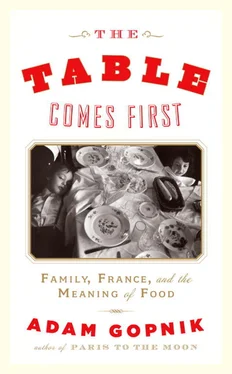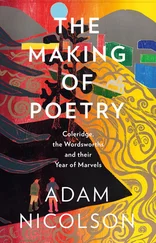Most books that have food in them, including the classic nineteenth-century novels, have the first kind of food. In one Trollope novel after another, three meals a day, the parsons and politicians eat chops or steaks or mutton, but the dishes are essentially interchangeable, mere stops on the ribbon of narrative, signs of life and social transactions rather than specific pleasures: “Mr. Peregrine greatly enjoyed his chop” or “For Dr. Patterson, even the usual satisfaction he took in his beefsteak and porter was somewhat diminished by this thought”—such food provides space for a moment of reflection. The dishes are the foam peanuts in the packaging of classic narrative. There are moments in Trollope when what a character drinks matters—claret good or bad, porter or port—but his food is, in every sense, at the service of his story.
Next come the writers who dish up very particular food to their characters to show who they are. Proust is the second kind of writer, and Henry James is, too. Proust seems so full of food—crushed strawberries and madeleines, tisanes and champagne—that entire recipe books have been extracted from his texts. But he’s not a greedy writer; that his people are eating lobster or veal matters to who they are and how they feel about who they are, but we are not meant to leave the page hungry. Proust will say that someone is eating a meal of gigot with sauce béarnaise, but he seldom says that the character had a delicious meal of gigot with sauce béarnaise—although he will extend his adjectives to the weather, or the view. He uses food as a sign of something else. (It’s what social novelists, even mystically minded ones, always do: J. D. Salinger doesn’t like food, either, but the fact that his characters are eating snails or Swiss-cheese sandwiches tells so much about them that it must be noted, and felt, like every other detail.)
The third kind of writer is so greedy that he goes on at length about the things his characters are eating, or are about to eat—serving it in front of us and then snatching it from our mouths. Ian Fleming is obsessed with food; gluttony, even more than lust, is the electric current of his hero’s adventures. Newcomers to James Bond, imagining him to be the roughneck he has once again become in movies, will be startled to see how much time he spends in Casino Royale and the other early Bonds giving advice to his girls and his spy superiors on what to eat, with the author hovering over his shoulder as he examines the menu: the problem with caviar, Bond announces, is getting enough toast (not true); English cooking is the best in the world when it’s good (certainly not true then); and rosé champagne goes perfectly with stone crabs (very true). His creator, one feels as the excitement builds, is not just itemizing the food, waiter-like, but actually sitting at the table and sharing it with him.
The fourth kind of writer, ever more numerous, presents on the page not just the result but the whole process—not just what people eat but how they make it, exactly how much garlic is chopped, and how, and when it is placed in the pan. Sometimes entire recipes are included in the text, a practice that links Kurt Vonnegut’s Deadeye Dick to Nora Ephron’s Heartburn , novels about the inadvertent mayhem that a man can inflict on a woman; in Heartburn , the recipes serve both as a joke about what a food writer writing a novel would write and as a joke on novel-writing itself by someone who anticipates that she will not be treated as a “real” novelist. These days, we have long cooking sequences in Ian McEwan; endless recipes in James Hamilton-Paterson; menus analyzed at length in John Lanchester; and detailed culinary scenes involving Robert B. Parker’s bruiser of a detective, Spenser. Cooking is to our literature what sex was to the writing of the sixties and seventies, the thing worth stopping the story for to share, so to speak, with the reader.
Not long ago, I attempted to mimic some cooking as it is done in a number of relatively recent novels. I began, foolishly, with several recipes from Günter Grass’s Nobel Prize–provoking The Flounder , the epic allegory of German history told through the endlessly repeated parable of an evil fish, a gullible man, a virtuous woman, and a lot of potatoes. The talking Flounder, being both the evil daemon and the central consciousness of the piece, has a natural class interest in flounders’ not being eaten, so there is a shortage of fish recipes in The Flounder . (I was tempted by a detailed description of how to make stewed tripe, but who in my gang would eat stewed tripe?) There is one nice moment, though, when the eternal talking Flounder, who “knew all the recipes that had been used for cooking his fellows,” mentions simmering the fish with white wine and capers. Well, from his mouth to our plate: I did just that, with a nice filet from the Citarella market, and, as suggested, added some sorrel. Then, learning in a later section what could be done with potatoes and mustard—the potato, with its false promise of cheap nutrition for all, is, I suppose, meant to represent the false hope of the Enlightenment in Germany, but the mustard surely could represent the saving genius of the Bavarian rococo—I made a gratin with mustard to accompany it. It was fine, though it reminded me of why it is that, at a moment when Spanish cooking is everywhere sanctified and even English cooking, for the first time, canonized, not many people are making a case that German cooking is much more than fish and potatoes and sauerbraten. Eating Günter Grass’s flounder was actually like reading one of his novels: nutritious, but a little pale and starchy.
Great masters are not meant to offer small plates. My eye fell next on School Days , one of Robert B. Parker’s excellent Spenser mysteries. Where John D. MacDonald’s Travis McGee, Spenser’s daddy in the genre, would occasionally throw an inch-thick T-bone on the grill of The Busted Flush , Spenser produces entire dishes, and we read about them bit by bit. (Nero Wolfe had a personal chef, and ate a lot, but it was mostly in the “the great detective dined on quenelles de brochet ” line.) In School Days , Spenser, with his beloved Susan away at a psych seminar, and only the dog for company, makes a dish of cranberry beans, diced steak, and fresh corn, dressed with olive oil and cider vinegar.
The beans alone establish Spenser’s credibility as a cook. “I shelled the beans from their long, red-and-cream pods and dropped them in boiling water and turned down the heat and let them simmer,” he tells us. A devotion to shell beans, I have noticed, divides even amateur cooks from noncooks more absolutely than any other food, and they are, into the bargain, a perfect model of writing. Like sentences, shell beans are a great deal more trouble to produce than anyone who isn’t producing them knows. You have to shell the beans, slipping open the pods with your thumbnail and then tugging the beautiful little prismatic buttons from their moorings—a process that, like writing, always takes much longer than you think it will. And then even the best shell beans, cleaned and simmered, are like sentences in that nobody actually appreciates them as much as they deserve to be appreciated. Shell beans are several steps more delicious, lighter and finer, than dried beans, let alone canned beans; but the sad truth is that nobody really cares beans about beans, and not many eaters can tell the fresh kind from the dried, or even the canned.
I carried on with the recipe: Spenser takes a small steak from the refrigerator and dices it, sautés it, and then mixes it with the beans and some corn. I did this, and, honestly, I don’t think it’s a good idea. Maybe I didn’t do it right—there is a certain lack of specificity about what kind of steak he’s using and just how long he keeps it in the pan—but I found that my steak dried out when it was diced and cooked, and, anyway, didn’t have enough salty punch to play off against the floury blandness of the beans. Sausage, not steak, is what’s called for here. As for the corn, well, even off-season corn is pretty tasty mixed with oil and vinegar, and makes a good combo with the shell beans. It’s a nice dish, worth interrupting the murders for.
Читать дальше












